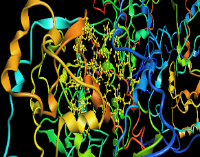In Silico Screening of Chemical Compounds from Green Chiretta (Andrographis paniculata (Burm. F.) Nees) as Cyclooxygenase-2 Inhibitors
Main Article Content
Abstract
Andrographis paniculata (Burm. F.) Nees commonly called Green Chiretta has been shown to have numerous pharmacological activities including anti-inflammatory activity. The present study aimed to determine the potential cyclooxygenase-2 inhibitory activity of compounds from Green Chiretta via in silico approach. The 3D structure of the enzyme cyclooxygenase-2 was obtained from Protein Data Bank (PDB) with code 1CX2. The 2D structures of forty-four compounds from Green Chiretta were obtained from “Take Out ‘Jamu’ KnapSack” website. The 2D structures were converted to 3D structures using ACD/ChemSketch programme. Optimization of the ligands was performed using VEGA ZZ programme. The docking of the 44 compounds with the target receptor cyclooxygenase-2 was done using the ArgusLab programme. The docking results were reported in terms of the change in free energy (ΔG). Docking results showed that two chemical compounds; 14-Deoxyandrographolide and Andrographic acid from Green Chiretta have the potential as cyclooxygenase-2 inhibitor, and showed synergistic activity with andrographolide with low free energy change (ΔG) of -12.7837 Kcal/mol and -13.4661 Kcal/mol for 14-Deoxyandrographolide and Andrographic acid, respectively. These results therefore revealed the potential of Andrographis paniculate as source of anti-inflammatory drug candidates with selective cyclooxygenase-2 inhibitory activity.
Downloads
Article Details

This work is licensed under a Creative Commons Attribution-NonCommercial-NoDerivatives 4.0 International License.
References
1. Ennane S, Baker L, Mulcahy A. Estimating the Cost of Industry Investment in Drug Research and Development: A Review of Methods and Results. Inquiry. 2021; 58:469580211059731.
2. Najib A, Wahyuni N, Abidin Z. Utilizing the Pyrx Program to Conduct In Silico Screening of Polyphenol Compounds as Potential Inhibitors of the Epidermal Growth Factor Receptor (EGFR) in Mango Plants (Mangifera indica). Trop J Nat Prod Res. 2023; 7:4284–4288.
3. Leng XY, Gao S, Ma YF, Zao LX, Wang M, Ye F, Fu Y. Discovery of Novel HPPD Inhibitors: Virtual Screening, Molecular Design, Structure Modification and Biological Evaluation. Pestic Biochem Physiol. 2023; 192:105390.
4. Gaudêncio SP, Bayram E, Lukić Bilela L, Mercedes C, Ana R, Berat HZ, Carlos J, Manolis M, Florbela P, Fernando R. Advanced Methods for Natural Products Discovery: Bioactivity Screening, Dereplication, Metabolomics Profiling, Genomic Sequencing, Databases and Informatic Tools, and Structure Elucidation. Mar Drugs. 2023; 21:308.
5. Jensen PH, Schlossmacher MG, Stefanis L. Who Ever Said It Would Be Easy? Reflecting on Two Clinical Trials Targeting α-Synuclein. Mov Disord. 2023; 38:378–384.
6. Najib A, Handayani V, Ahmad AR, Hikmat S. In silico Screening Chemical Compounds α-Glucosidase Inhibitor From Cordia myxa L. Int J Res Pharm Sci. 2019; 10:2054–2057.
7. Dai X and Chen Y. Computational Biomaterials: Computational Simulations for Biomedicine. Adv Mater. 2023; 35:e2204798.
8. Niazi SK and Mariam Z. Recent Advances in Machine-Learning-Based Chemoinformatics: A Comprehensive Review. Int J Mol Sci. 2023; 24:11488.
9. Demir H, Daglar H, Gulbalkan HC, Aksu GO, Keskin S. Recent Advances in Computational Modeling of MOFs: From Molecular Simulations to Machine Learning. Coord Chem Rev. 2023; 484:215112.
10. Niazi SK and Mariam Z. Computer-Aided Drug Design and Drug Discovery: A Prospective Analysis. Pharmaceuticals. 2023; 17:22.
11. Yang S and Kar S. Application of Artificial Intelligence and Machine Learning In Early Detection Of Adverse Drug Reactions (ADRs) And Drug-Induced Toxicity. Artif Intell Chem. 2023; 1:100011.
12. Korn M, Ehrt C, Ruggiu F, Gastreich M, Rarey M. Navigating Large Chemical Spaces in Early-Phase Drug Discovery. Curr Opin Struct Biol. 2023; 80:102578.
13. Benjaponpitak A, Sawaengtham T, Thaneerat T, Kulthanit W, Palang C, Chalermquan R, Sakkarin B, Sataporn C, Sewat B, Sarawut L. Effect of Andrographis paniculata Treatment for Patients With Early-Stage COVID-19 on the Prevention of Pneumonia: A Retrospective Cohort Study. MedRxiv. 2023; 2003–2023p.
14. Awotauw EL and Panggabean RM. Analysis of Ethnopharmacological Studies on the Use of the Sambiloto Plant in the Treatment of Malaria in the Asmat Tribal Community in Papua, Indonesia. Eureka Herba Indones. 2024; 5:446–451.
15. Maulana S. Conservation and Exploration of the Potential of Rare Medicinal Plants in the Tropical Rainforest of Bukit Barisan, Sumatra, Indonesia: An Effort Towards Sustainable Herbal Medicine. Eureka Herba Indones. 2024; 5:452–459.
16. Ugrasena PY, Nugraha IS, Dewi NWRK. Andrographolide: Potency as Antiatherosclerosis in Il-1βCytokine. J Ilm Kesehat Sandi Husada. 2023; 12:190–200.
17. Sulaiman I, Okwuofu EO, Mohtarrudin N, Lim JCW, Stanslas J. An Andrographis paniculata Burm. Nees Extract Standardized for Three Main Andrographolides Prevents House Dust Mite-Induced Airway Inflammation, Remodeling, and Hyperreactivity by Regulating Th1/Th2 Gene Expression in Mice. J Ethnopharmacol. 2024; 319:117082.
18. Hosawi S. Current Update on Role of Hesperidin in Inflammatory Lung Diseases: Chemistry, Pharmacology, and Drug Delivery Approaches. Life. 2023; 13:937.
19. Nasution AK, Ono N, Kanaya S, Ul-Amin MA. Investigating Potential Natural Antibiotics Plants Based on Unani Formula Using Supervised Network Analysis and Machine Learning Approach. IEEE Int Conf Bioinform Biomed. 2023: 3111-3117p.
20. Callil-Soares PH, Biasi LCK, Pessoa Filho P de A. Effect of Preprocessing and Simulation Parameters on the Performance of Molecular Docking Studies. J Mol Model. 2023; 29:251.
21. Jarrah A and Lababneh J. A New Optimized Hybridization Approach for In Silico High Throughput Molecular Docking on FPGA Platform. Curr Comput Aided Drug Des. 2024; 20:236–247.
22. Low M, Suresh H, Zhou X, Jyoti BD, Muhammad A, Khoo C, Gerald M, Li CG . The Wide Spectrum Anti-Inflammatory Activity of Andrographolide in Comparison to Nsaids: A Promising Therapeutic Compound Against the Cytokine Storm. BioRxiv. 2024: 2002–2024p.
23. Sun X, Yu Y, Saleh ASM, Hassan AK, Li W, Dequan Z, Wang Z. Conformational Changes Induced by Selected Flavor Compounds from Spices Regulate the Binding Ability of Myofibrillar Proteins to Aldehyde Compounds. Food Chem. 2024; 451:139455.
24. Morton W, Vácha R, Angioletti-Uberti S. Valency of Ligand-Receptor Binding from Pair Potentials. J Chem Theory Comput. 2024; 20(7):2901-2907
25. Ali KA, Maity A, Roy SD, Pramanik SD, Das PP, Shaharyar MA. Insight into the mechanism of steroidal and non-steroidal anti-inflammatory drugs. In: Kazmi I, Karmakar S, Shaharyar MA, Afzal M, Al-Abbasi FA, eds. How Synthetic Drugs Work. Academic Press; 2023. 61-94p.


